Yellowstone National Park is home to over 300 species of birds, making it a haven for bird lovers and enthusiasts.
The park’s diverse habitats, ranging from grassy meadows, and dense forests, to bubbling hot springs, provide a rich ecosystem, that supports the flourishing of a vast array of birdlife.
Birdwatchers visiting Yellowstone can spot raptors such as bald eagles, osprey, and peregrine falcons, and also sight owls, ducks, geese, and songbirds.
Yellowstone National Park is a magnificent and unique ecosystem that hosts various activities, including birding, which attracts thousands of visitors every year.
This article aims to provide insightful facts about the birds in Yellowstone National Park, their habitats, and the best time to observe them in the park.
1. Mountain Bluebird
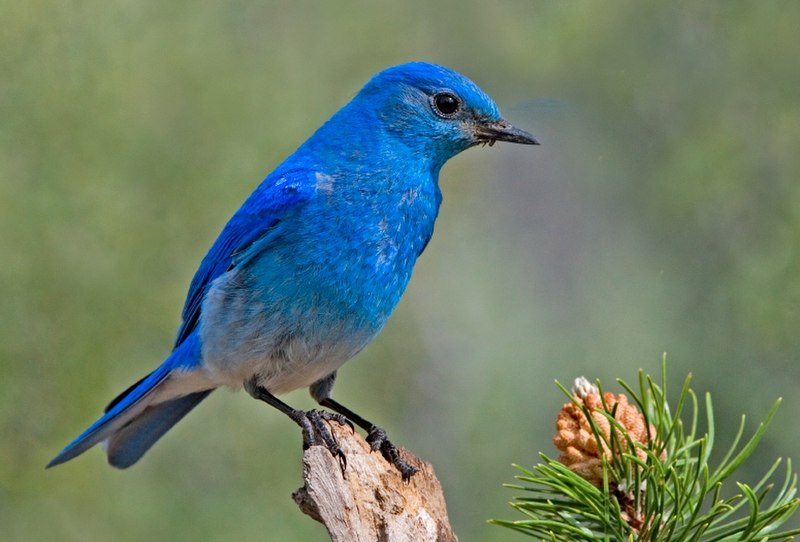
The Mountain Bluebird is a beautiful sight to behold. It has bright turquoise-blue wings and tail, with a light underbelly, grey crown, and breast, black eyes, and thin bills.
During the fall season, its plumage changes slightly – females have duller blue wings and tails, as well as a grey throat and back.
As they migrate across western North America during springtime these birds can be found in mountainous districts where they feed on insects such as grasshoppers or crickets collected from meadows or fields of grain.
They also enjoy eating berries when available. Through their stunning colors, this species adds vibrancy to any landscape it traverses through – truly an incredible creature of nature.
Scientific classification:
| Kingdom | Animalia |
| Phylum | Chordata |
| Class | Aves |
| Order | Passeriformes |
| Family | Turdidae |
| Genus | Sialia |
| Species | S. currucoides |
Also Featured In: Most Common United States Birds, Blue Birds You’ll Found around Us
2. Bald Eagle
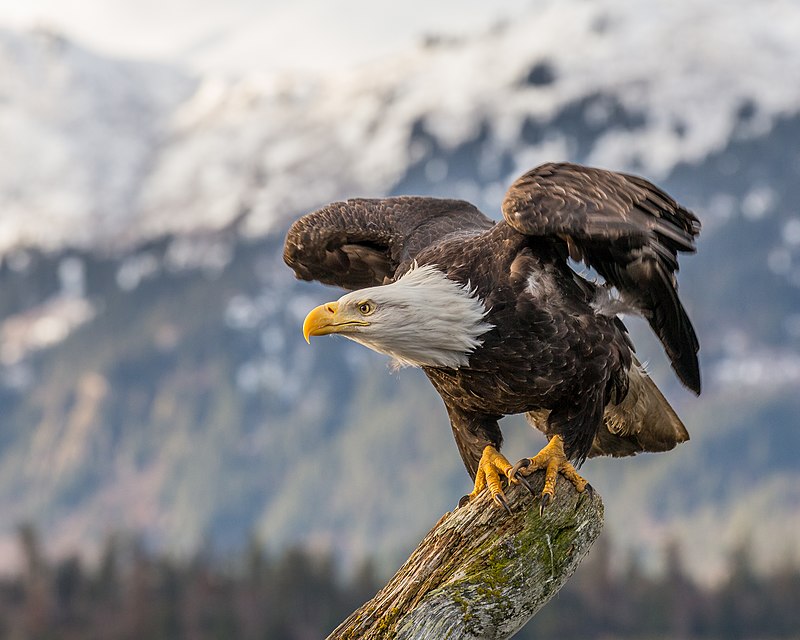
The majestic Bald Eagle is a bird of prey found in North America and recognized as the national symbol of the United States.
With its distinctive white head, brown body, and striking yellow beak, this sea eagle has two known subspecies that form a species pair with the White-tailed Eagle.
It inhabits much of Canada, Alaska all states in the US contiguous area, and Northern Mexico near large bodies of water where they feed mainly on fish.
These birds have an impressive wingspan ranging from 1.8 to 2 meters depending on their size making them one of nature’s most magnificent creatures.
Scientific classification:
| Kingdom | Animalia |
| Phylum | Chordata |
| Class | Aves |
| Order | Accipitriformes |
| Family | Accipitridae |
| Genus | Haliaeetus |
| Species | H. leucocephalus |
Also Featured In: Birds Live in Arkansas, Flight Birds You Should Know
3. American White Pelican
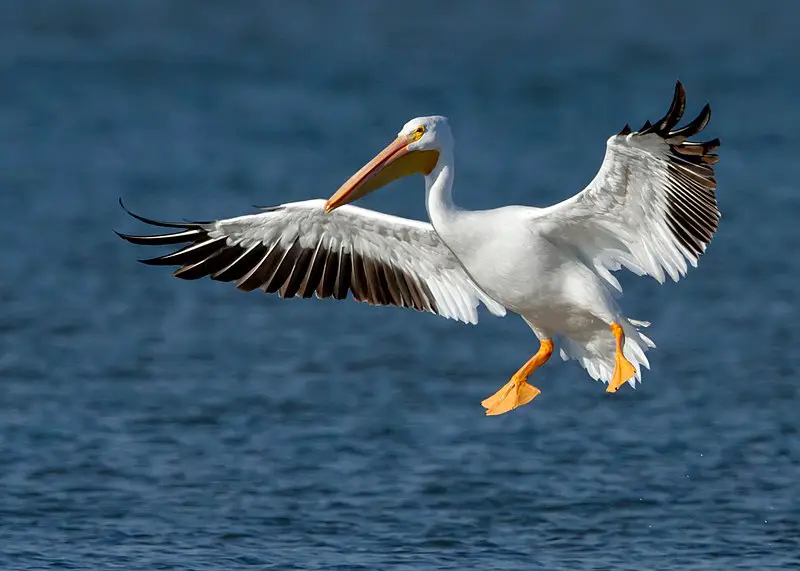
The American White Pelican is a majestic bird from the Pelecaniformes order, known for its impressive size and ability to soar gracefully in the sky.
It breeds during summer months in North America and migrates southwards towards Central and South America during winter.
The species was first described by German naturalist Johann Friedrich Gmelin back in 1789 as part of his updated version of Carl Linnaeus’ work.
This large aquatic bird has an all-white plumage with black primary flight feathers on its wings, while its beak features a characteristic yellowish coloration at the base near the face.
Its diet mainly consists of fish which it typically catches after dipping into water using its long bill; yet sometimes they can be seen stealing food items from other birds such as cormorants or gulls.
Scientific classification:
| Kingdom | Animalia |
| Phylum | Chordata |
| Class | Aves |
| Order | Pelecaniformes |
| Family | Pelecanidae |
| Genus | Pelecanus |
| Species | P. erythrorhynchos |
Also Featured In: Most Popular Bird Species in North America, Birds You’ll Find in South Texas
4. Yellow-Rumped Warbler
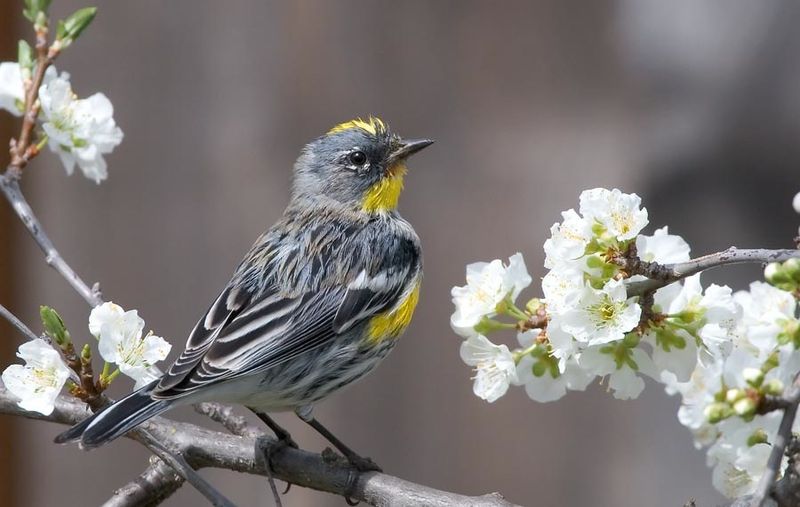
The Yellow-rumped Warbler (Setophaga coronata) is a migratory bird species that can be found throughout North America.
It has an extensive range, from the Pacific and Atlantic coasts of the US to Canada and Central America, with a concentration in northern areas during the breeding season.
These birds migrate southwards for wintering grounds where they find plentiful food sources such as insects and berries.
They are easily identified by their yellow patches on either side of their tails, along with white underparts, gray back feathers, and two distinct crown stripes.
One black or greyish-brown above the eyes extending towards its neck banded in yellow or light brown coloration.
Furthermore, these warblers have strong legs which allow them to cling onto branches while hunting for prey making them adept at maneuvering through tree cover quickly.
Altogether this makes the Yellow-rumped Warbler an attractive backyard visitor year-round.
Scientific classification:
| Kingdom | Animalia |
| Phylum | Chordata |
| Class | Aves |
| Order | Passeriformes |
| Family | Parulidae |
| Genus | Setophaga |
| Species | S. coronata |
Also Featured In: Most Common Winter Birds, Birds Live Near San Diego
5. Canada Jay
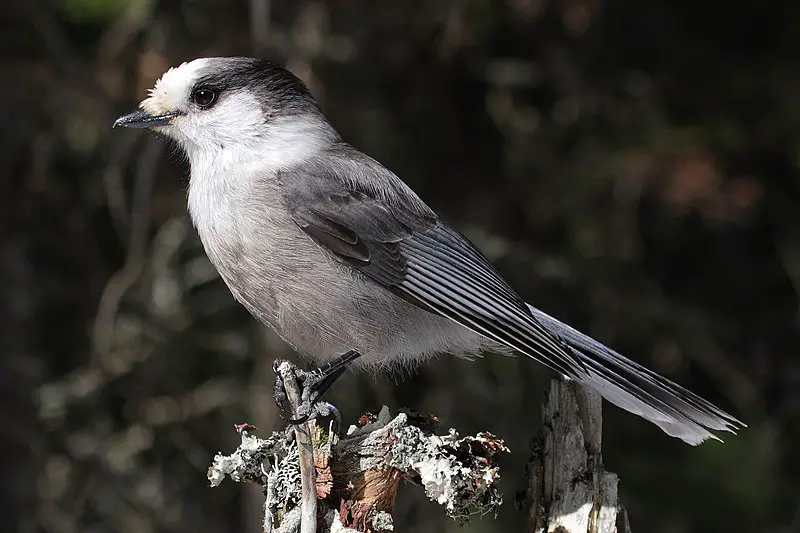
The Canadian jay is a beautiful bird that can be found in many parts of North America. It has pale grey underparts and darker grey upperparts, making it easy to identify from other birds.
Its wingspan typically measures around 13 inches long and its body length up to 9 inches, giving it the nickname ‘Whiskey Jack’ or ‘Camp Robber’.
These birds are usually seen foraging on the ground for food like fruits and small insects, although they also eat carrion, eggs, and nestlings when available.
They often store their collected food in caches hidden among branches near their nests as well as trees throughout their territories during winter months.
Their high intelligence makes them very adaptive scavengers who survive harsh winters while still being able to take advantage of summer bounty.
All these traits make this species one of nature’s most fascinating creatures.
Scientific classification:
| Kingdom | Animalia |
| Phylum | Chordata |
| Class | Aves |
| Order | Passeriformes |
| Family | Corvidae |
| Genus | Perisoreus |
| Species | P. canadensis |
Also Featured In: Common Birds in Canada, Birds of Nova Scotia
6. Trumpeter Swan
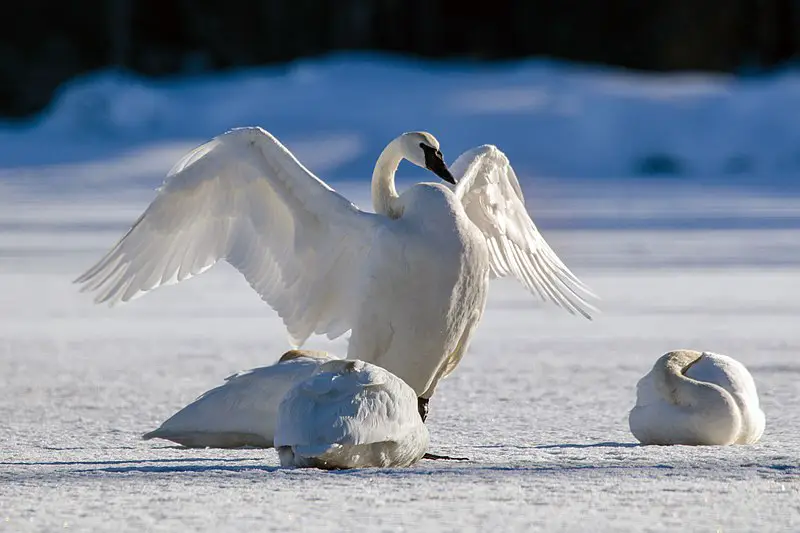
The majestic Trumpeter Swan is the largest native waterfowl in North America, with a wingspan of up to 8 feet.
Found throughout Canada and parts of the United States, this beautiful bird can live for up to 20 years.
It has black legs and a bill that is tipped yellow as well as snow-white feathers that help it stand out in its natural habitat.
The trumpeter swan’s diet consists mainly of aquatic vegetation such as roots, tubers, stems, leaves, and seeds which they find by wading into shallow waters or grazing on land.
These birds form strong family bonds; both parents raise their young together until they reach adulthood at four years old.
Through conservation efforts, these incredible creatures have been brought back from near extinction giving us all something special to appreciate.
Scientific classification:
| Kingdom | Animalia |
| Phylum | Chordata |
| Class | Aves |
| Order | Anseriformes |
| Family | Anatidae |
| Genus | Cygnus |
| Species | C. buccinator |
Also Featured In: Birds You’ll Find in Zoo, Common Birds in Alberta
7. Sandhill Crane
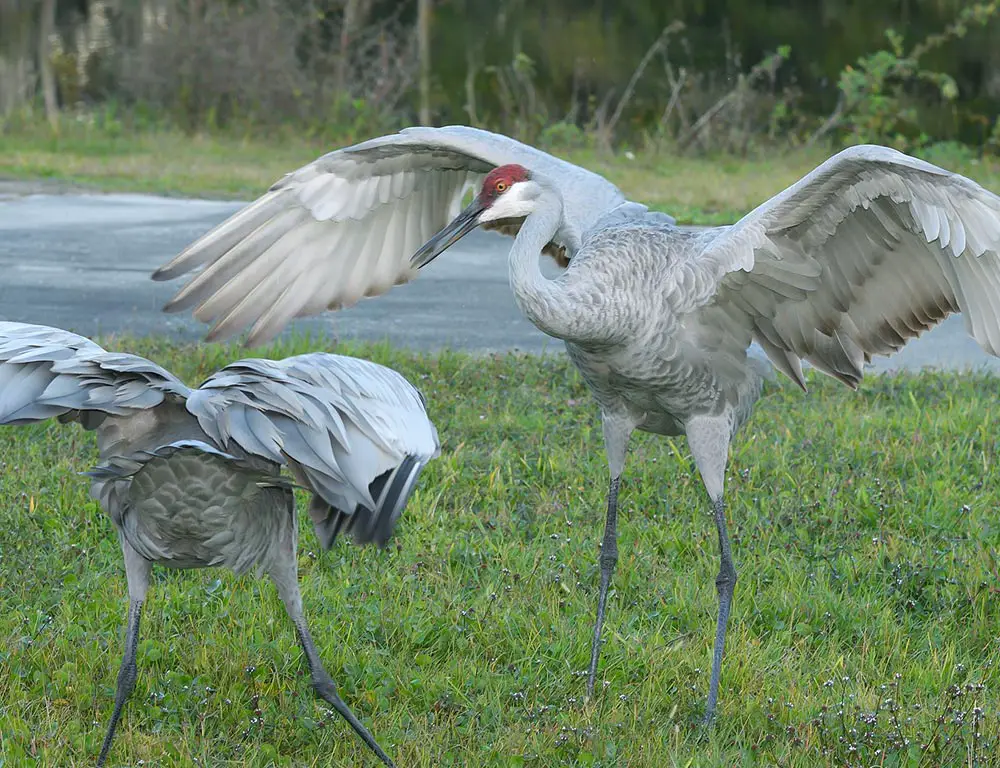
Sandhill Cranes are a large species of crane native to North America and northeastern Siberia. They are known for their distinctive calls, long legs, and long necks.
These birds typically inhabit wetland areas like the Platte River in Nebraska’s Sandhills on the Great Plains.
In Central Florida, they often gather at the edges of bodies of water such as lakes or rivers.
During the breeding season, sandhill cranes can be seen performing elaborate courtship dances that involve bowing and jumping in unison with their partner.
Their diet consists mainly of plant material including grains, roots, tubers, and aquatic plants which they obtain by pecking or digging into mudflats using their bill or feet respectively.
With an average lifespan between 10-20 years, these majestic creatures make great additions to any wetland habitat.
Scientific classification:
| Kingdom | Animalia |
| Phylum | Chordata |
| Class | Aves |
| Order | Gruiformes |
| Family | Gruidae |
| Genus | Antigone |
| Species | A. canadensis |
Also Featured In: Most Common Types of Birds Found in Cuba, Flocks Birds around Us
8. Hammond’s Flycatcher
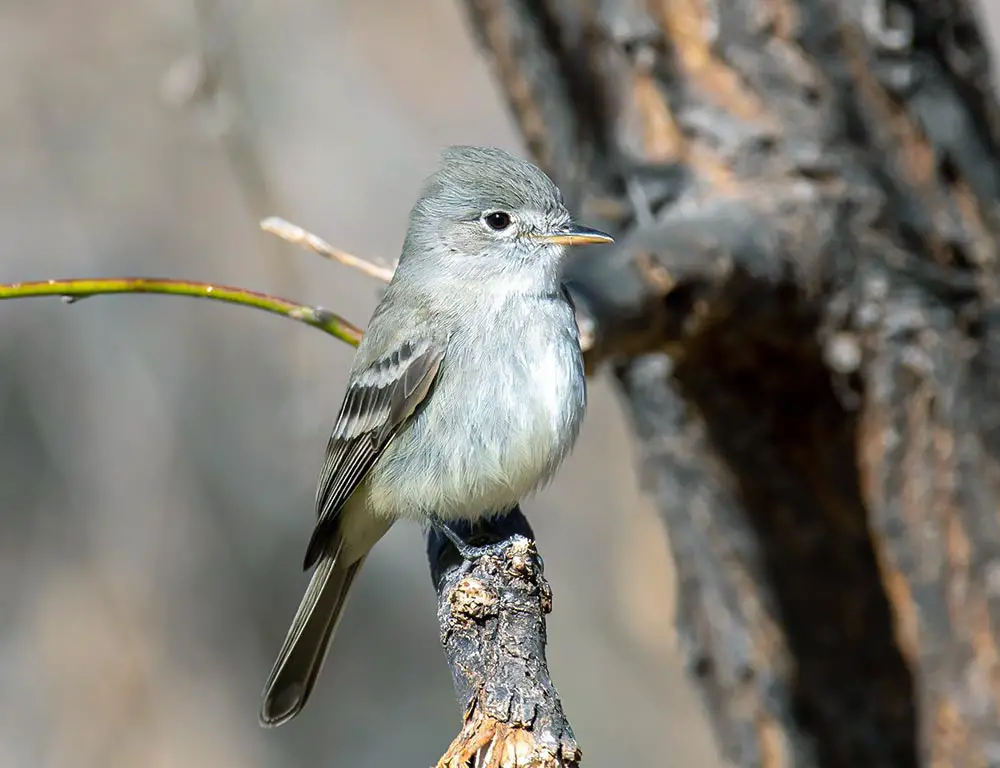
Hammond’s flycatcher is a small insectivorous bird found in the coniferous and mixed forests of Western North America.
It was named after William Alexander Hammond, who served as Surgeon General of the US Army and collected bird specimens for Spencer Fullerton Baird.
Adults measure between 12-14 cm long (4.7-5.5 inches) with a wingspan around 21cm (8 inches).
They have gray heads with yellowish eyestripe, olive backs, and whitish bellies; their tails are dark on top and lighter underneath but often barred by black feathers across it widthwise.
Males possess rusty red throats which can be seen when they sing from an open perch to advertise mating opportunities or defend territories against rival birds during breeding season – usually occurring April through May or June depending upon location.
Scientific classification:
| Kingdom | Animalia |
| Phylum | Chordata |
| Class | Aves |
| Order | Passeriformes |
| Family | Tyrannidae |
| Genus | Empidonax |
| Species | E. hammondii |
Also Featured In: Flycatchers Species, Birds that Live in Yosemite National Park
9. Northern Saw-Whet Owl
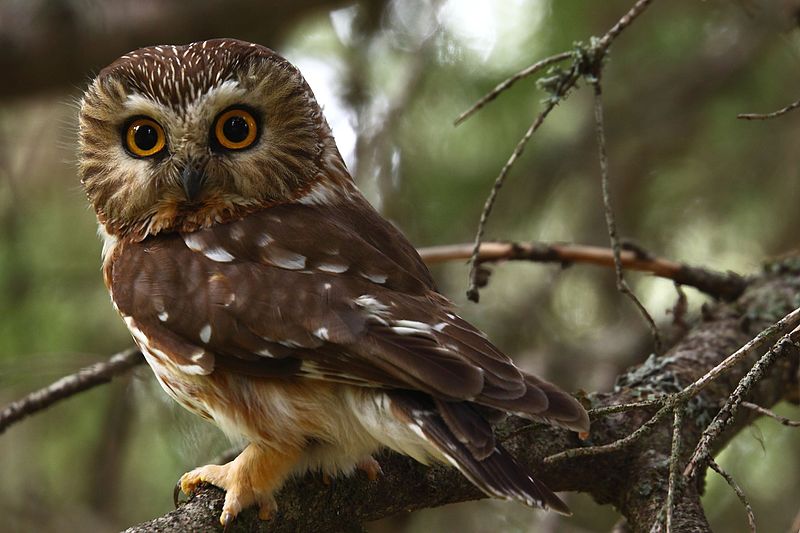
The Northern saw-whet owl is a small species of bird native to North America. It can be found in dense thickets, either at eye level or up to 20 feet high.
These owls are among the smallest species of their kind on the continent and have sharp claws for hunting prey such as rodents and other birds.
Due to its size, it often falls victim to predators like larger hawks and eagles which hunt them down relentlessly.
Fortunately, they camouflage well with their brown feathers that blend into trees easily giving them some protection from these hunters while they search for food during nighttime hours when most predators are asleep.
Scientific classification:
| Kingdom | Animalia |
| Phylum | Chordata |
| Class | Aves |
| Order | Strigiformes |
| Family | Strigidae |
| Genus | Aegolius |
| Species | A. acadicus |
Also Featured In: Owls Species, Common Southern Californian Birds
10. American Three-Toed Woodpecker
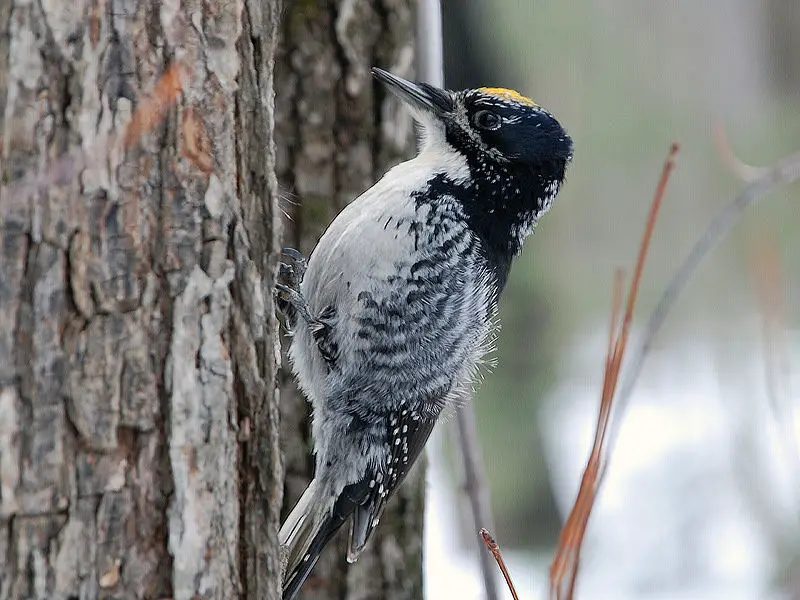
The American three-toed woodpecker is a medium-sized member of the Picidae family, native to North America.
It measures 8.3 inches in length and has a wingspan around 15 inches wide; it typically weighs 1.9 ounces.
This species closely resembles its black-backed relation, which also has three toes on each foot.
The maximum lifespan for this bird in its natural habitat is 6 years old – relatively short compared to other birds of similar size – but they are still highly valued as important members of their ecosystem.
They help control insect populations while providing an interesting display when observed up close or from afar.
Scientific classification:
| Kingdom | Animalia |
| Phylum | Chordata |
| Class | Aves |
| Order | Piciformes |
| Family | Picidae |
| Genus | Picoides |
| Species | P. dorsalis |
Also Featured In: Woodpeckers Species,
11. Red-Naped Sapsucker
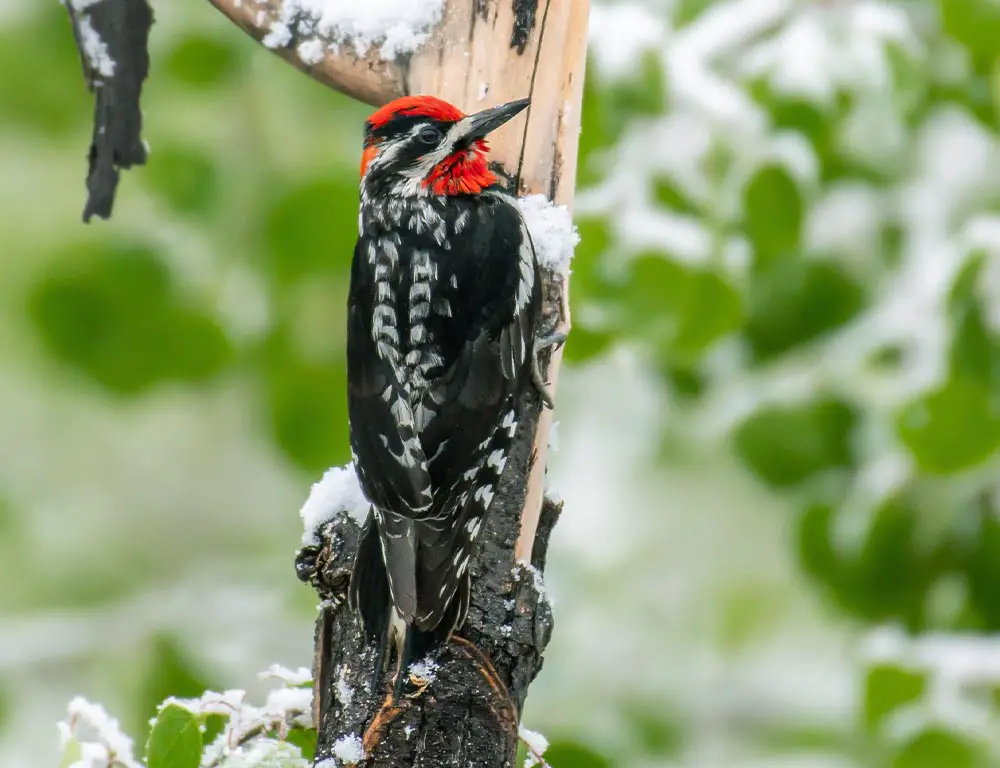
The Red-naped Sapsucker is a medium-sized woodpecker native to North America. It was initially thought to be a subspecies of the yellow-bellied sapsucker, but it has since been identified as its species.
This bird belongs in the genus Sphyrapicus and does not have any known subspecies. Its distinct red head patch makes this species easy to identify among other birds of its kind.
It can usually be found near conifers or deciduous trees that contain sap wells drilled by these birds for their food source – mainly insects and tree sap.
These birds are also known to eat fruits, berries, and nuts during winter months when bug populations decrease significantly.
The Red-naped Sapsucker is an important part of many ecosystems across North America due to their unique diet habits which provide essential nutrients needed for plant growth and health; making them a valuable asset in preserving forests everywhere.
Scientific classification:
| Kingdom | Animalia |
| Phylum | Chordata |
| Class | Aves |
| Order | Piciformes |
| Family | Picidae |
| Genus | Sphyrapicus |
| Species | S. nuchalis |
Also Featured In: Birds that Live in the Grand Canyon National Park, Common Birds of Antelope Island State Park
12. Williamson’s Sapsucker
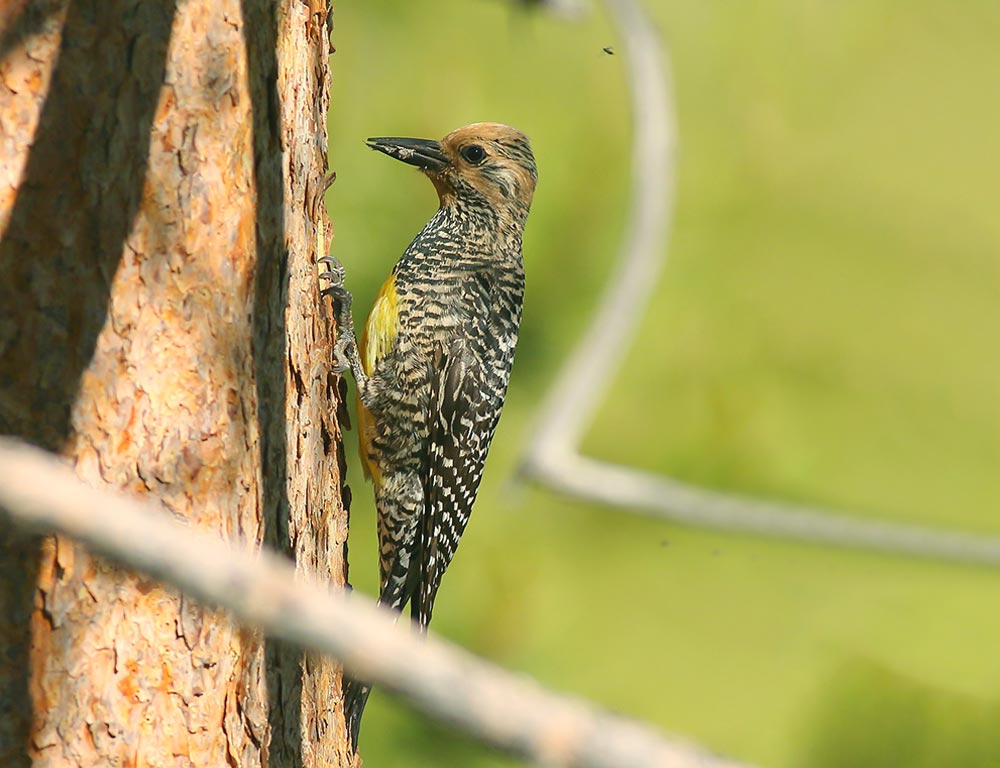
Williamson’s sapsucker is a medium-sized woodpecker belonging to the Sphyrapicus genus.
It inhabits open coniferous forests, particularly those of ponderosa pine, douglas-fir, and grand fir in western North America from northern British Columbia through California and as far east as Idaho.
During winter months it can also be found further south into Mexico. Williamson’s sapsuckers feed on arthropods that they drill out from tree bark or sap oozing from their feeding holes—hence its name.
They are an elegant species with glossy black wings patterned by white crescent-shaped marks; the back being barred yellowish grey while underparts have fine barring too with chestnut tones around the neck area.
In addition, red crowns make males easily distinguishable from females who sport dark brown heads instead.
Scientific classification:
| Kingdom | Animalia |
| Phylum | Chordata |
| Class | Aves |
| Order | Piciformes |
| Family | Picidae |
| Genus | Sphyrapicus |
| Species | S. thyroideus |
Also Featured In: Yellow Birds that Live in Colorado,
13. Black-Billed Magpie
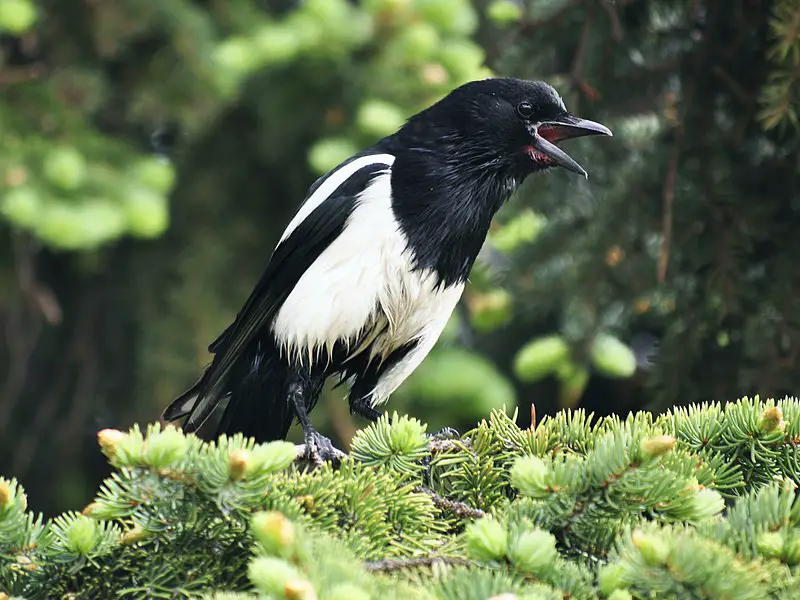
The black-billed magpie is an iconic bird of the western half of North America and one of only four songbirds with a tail that makes up over half its body length.
With their glossy black feathers offset by white patches, they can be seen in open woodlands or near agricultural areas.
Their diet consists mainly of insects, carrion, and grains but they often scavenge human food as well.
They are highly social birds who live in large groups and communicate through loud calls, snaps, and rattles when defending their territory from other airborne predators like hawks or eagles.
Magpies have proven to be hardy survivors despite habitat loss due to urbanization so there’s hope these remarkable birds will remain part of our landscape for many years to come.
Scientific classification:
| Kingdom | Animalia |
| Phylum | Chordata |
| Class | Aves |
| Order | Passeriformes |
| Family | Corvidae |
| Genus | Pica |
| Species | P. hudsonia |
Also Featured In: Utah Birds, Birds That Live in Colorado
14. Western Tanager
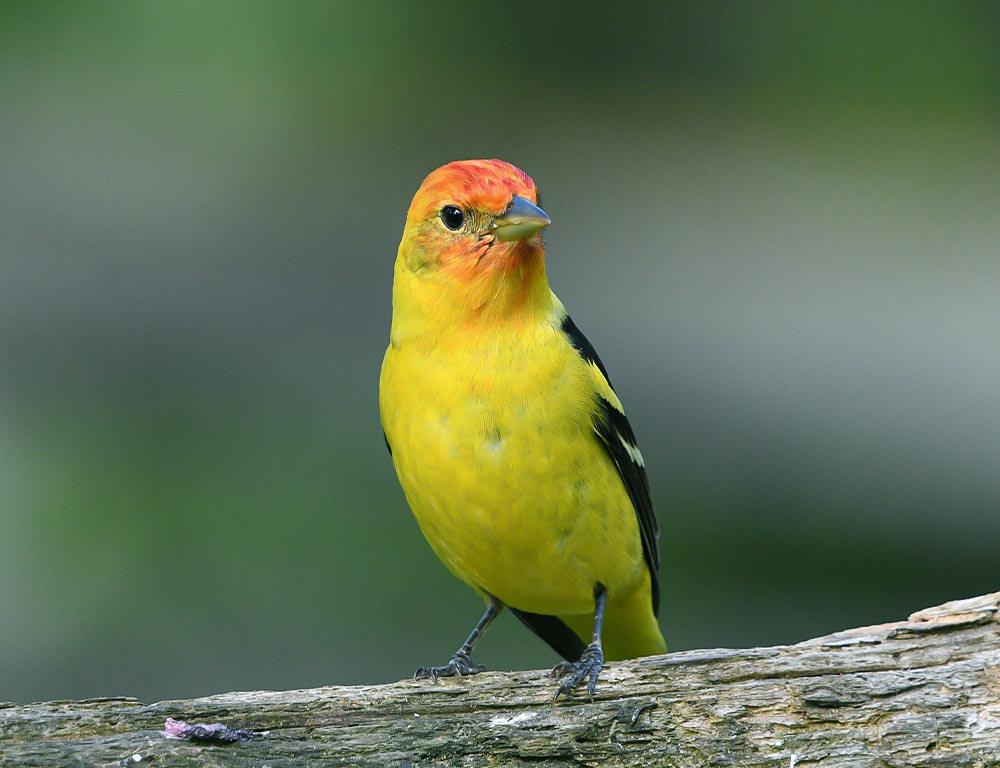
The Western Tanager (Piranga ludoviciana) is a medium-sized songbird belonging to the cardinal family, Cardinalidae. It was illustrated and formally described by American ornithologist Alexander Wilson in 1811.
The species has distinctive plumage including yellow feathers on its wings and tail, red shoulders, a black head with a white forehead patch, and grayish underparts.
Its vocalizations are also very similar to other members of the cardinal family – they have a high-pitched ‘tsee’ note followed by several sweeter notes that come together as parts of complex songs.
They primarily feed on fruit but will also take insects when available for extra protein during the breeding season.
These beautiful birds can be found throughout western North America from Alaska down through Mexico making them an iconic part of many landscapes.
Scientific classification:
| Kingdom | Animalia |
| Phylum | Chordata |
| Class | Aves |
| Order | Passeriformes |
| Family | Cardinalidae |
| Genus | Piranga |
| Species | P. ludoviciana |
Also Featured In: Lake Tahoe Birds, Birds in Calgary You’ll Love to See
15. Dusky Grouse
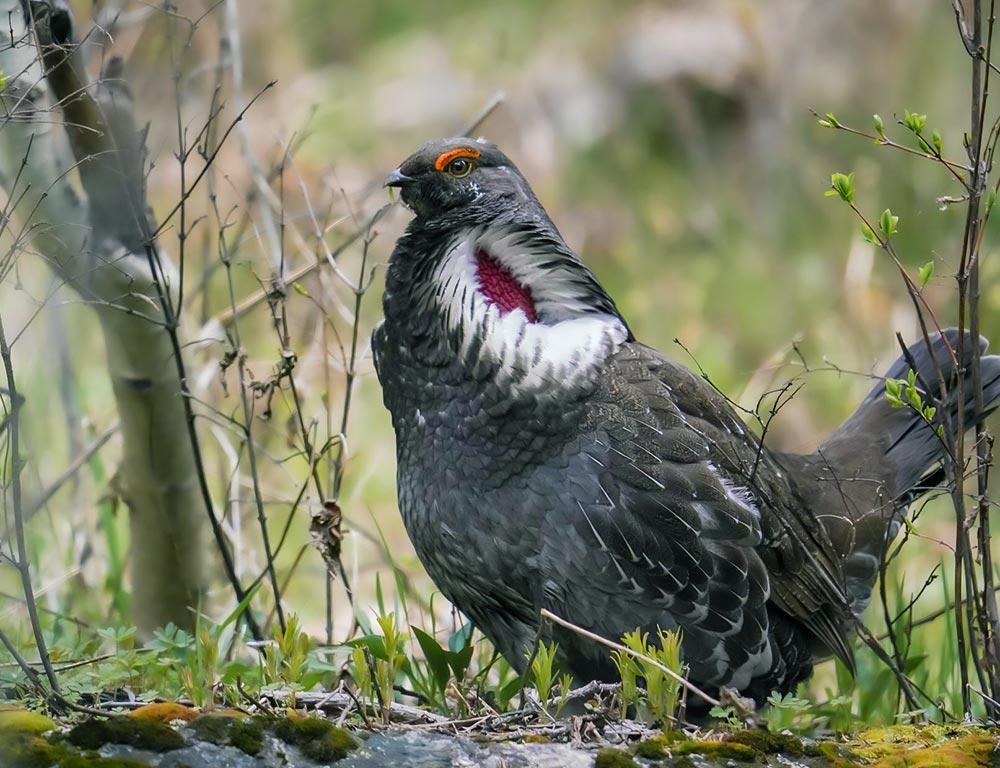
The Dusky grouse is a bird species found in the Rocky Mountains of North America. It is closely related to the Sooty grouse and was previously considered the same species as the Blue grouse.
This bird is primarily dark in color with a purplish throat air sac surrounding the neck of the adult male.
They have a long and square-shaped tail that is gray at the end. As forest-dwelling birds, Dusky grouse are commonly seen in coniferous forests during the breeding season.
They prefer to feed on the buds, flowers, and leaves of trees and shrubs. These birds are well-adapted to their environment and are known for their unique behaviors during the breeding season, which include elaborate courtship displays and vocalizations.
The Dusky grouse is an important species that plays a vital role in maintaining the ecological balance of their habitat.
Scientific classification:
| Kingdom | Animalia |
| Phylum | Chordata |
| Class | Aves |
| Order | Galliformes |
| Family | Phasianidae |
| Genus | Dendragapus |
| Species | D. obscurus |
Also Featured In: Blue Birds that You’ll Find in Utah, Yellowstone National Park Birds You Need To Know
16. Wilson’s Snipe
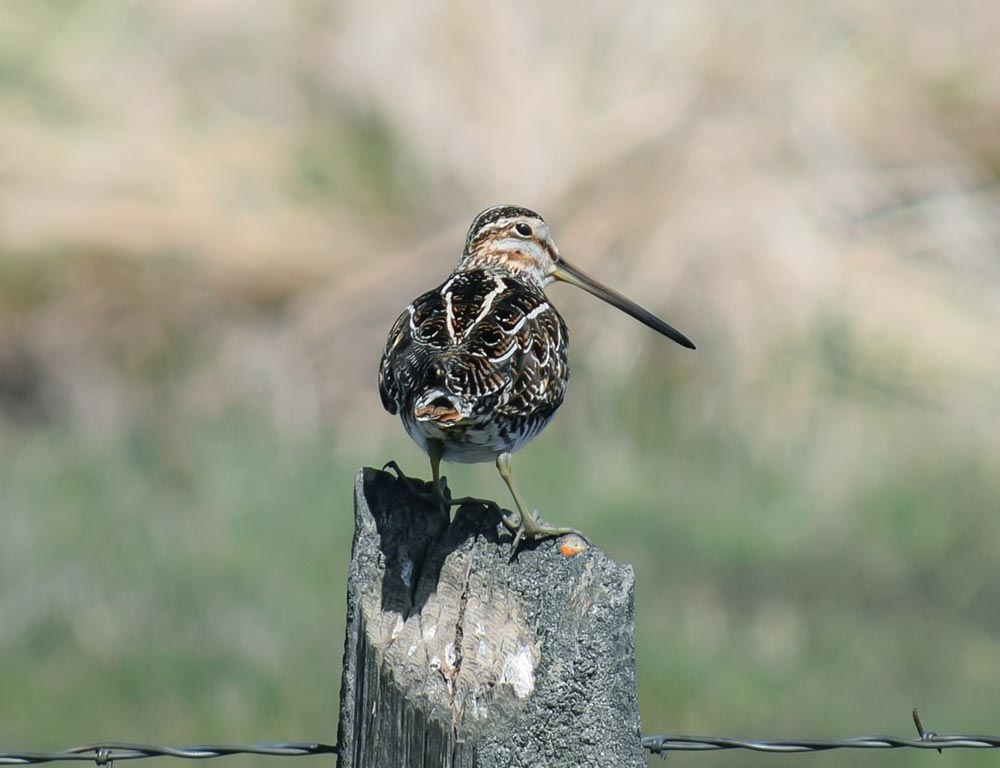
Wilson’s snipe is a small shorebird characterized by its stocky physique. Its genus name, Gallinago, refers to it being a woodcock or snipe, while its specific name, delicata, means “dainty” in Latin.
This bird used to be a subspecies of the common snipe until 2003 when it was recognized as a distinct species.
Despite its small size, the Wilson’s snipe is highly capable in flight and has been known to fly thousands of miles during migration.
Its distinctive bill, which is long and straight, is used primarily for probing in the mud for food. Although it is primarily found in wetlands and marshes, this bird may also venture into other habitats during breeding season.
The Wilson’s snipe has a unique mating call, which sounds like a winnowing or bleating sound, and can often be heard during early mornings and late evenings in their breeding territories.
Scientific classification:
| Kingdom | Animalia |
| Phylum | Chordata |
| Class | Aves |
| Order | Charadriiformes |
| Family | Scolopacidae |
| Genus | Gallinago |
| Species | G. delicata |
Also Featured In: Caribbean Birds, Native Birds Of West Swan Island
Conclusion
Our exploration of the 16 birds found in Yellowstone National Park has offered a glimpse into the diverse avian life thriving in this iconic wilderness.
From the majestic bald eagle soaring over its rivers to the vibrant colors of the Western tanager adorning its forests, Yellowstone’s birdlife is a testament to the park’s ecological richness. As we wrap up this journey, it’s essential to remember the importance of conservation.
By respecting the park’s regulations, protecting its habitats, and supporting conservation initiatives, we can ensure that these feathered inhabitants continue to grace Yellowstone’s skies and contribute to the park’s unique natural beauty for generations to come.